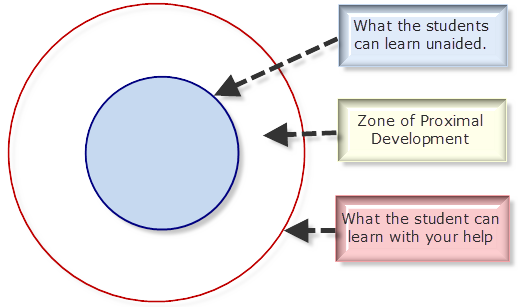In 1934 the Russian psychologist Vygotsky firstly demonstrated the importance of others as learning mediators and he explained how social experience interacted with human mental activity. He introduced the way learners interact with others/teachers is through Zone of Proximal Development (ZPD), where a student learn a certain amount of information/knowledge by his/her own, while with teacher’s help can learn more (Figure 1).
Teacher’s role, as a facilitator, is to identify in which stage the student is and to provide him/her suitable material. Initially, with teachers’ encouragement and the provided learning material, students will move on a next level of learning and gradually they will withdraw teacher’s support becoming a more independent learning. Teachers’ aim is to provide ‘scaffolding’ support and assist students to make the external knowledge part of their own. The previous knowledge of student plays a significant role in this learning process.
Discussion in education is not a new concept; however in some sense it is unique, as it is based on participants’ own experience and their interpretations of the experience.
All members in a class (including teacher) takes place in this learning process. This means that a student firstly learn by own experience and then (s)he can learn in collaboration with others and teacher’s contribution.
Collaborative learning is another framework of Socio-cultural Constructivism, where students in the same group/class exchange ideas/views/ data as they are working with one another. Collaborative learning may deal with a large group in Higher Education.
Ellis et al. (1991) categorised group interactions according to time and space (Figure 2). Collaboration could be enhanced within a real-time interaction or an asynchronous (non-real time interaction). A distinction is made between same time (synchronous) and different times (asynchronous), and between same place (face-to-face) and different places (distributed).
Face-to-face interactions take place in a classroom/ lecture theatre, as they happen at the same place and same time.
Asynchronous communication is very different from face-to-face communication and allows students to exchange data and views in their own time and space (e-mail has been originally designed for supporting this communication). Though this type of collaboration students are not pressed to react in a shot unit of time and they can organise their messages/comments by “branching” them around themes (Veerman et al., 2000). Asynchronous communication can be supported by the interactive VLE tools such as discussion forums, blogs, wikis. and social media.
Some recommendations for effectively asynchronous communication/collaboration in education
- Students work in teams;
- teachers or group teams should provide feedback in summary form and not to response to each post individually;
- teachers provide at the beginning of the activity/communication/collaboration clear instructions to students;
- teachers encourage students to provide peer feedback; and
- teachers should choose tools which support posting notifications; otherwise (s)he should inform students how often (s)he will visit and take place in online discussions.
Issues with the asynchronous communication teachers may have
- when two or more group members are coming from different countries or have different background knowledge and/or have not previously worked together to work on a common task electronically (Jaervelae et al., 2004); and
- when students do not receive instant feedback from their questions and cannot talk in real-time about results obtained in the leanring activities. These isolation feelings may cause motivation reduction for learning (Jara, et al., 2009).
Synchronous environments students share data and views through the Internet in real-time like a face-to-face interaction without feeling isolated (Marjanovic, 1999). Synchronous communication can be supported, for example by live chat room or Twitter’s real-time discussion, where users receive a response within seconds or minutes.
Some recommendations for effectively synchronous communication/collaboration in education:
- teachers and/or a small group of students should meet each other online;
- teachers should provide clear instructions for using online chats/collaboration in real-time;
- teachers should choose tools and procedures that allow him/her to moderate the online chat/collaboration in real-time;
- students should have the opportunity to meet frequent; and
- students should read the posts/messages and activity contribute to the discussion (limited amount of “lurking” for students).
References
Carlile, O., & Jordan, A. (2005). It works in practice but will it work in theory? The theoretical underpinnings of pedagogy. In G., O’Neill, S., Moore, & B., McMullin, B. (Eds) Emerging Issues in the Practice of University Learning and Teaching. Dublin: AISHE, http://www.aishe.org/readings/2005-1/
Ellis, C. A., Gibbs, S. J., and Rein, G. (1991). Groupware: Some issues and experiences. Communications of the ACM, 34(1), 39–58.
Jara, C. A., Candelas, F. A., Torres, F., Dormido, S., Esquembre, F. & Reinoso O. (2009). Real-time collaboration of virtual laboratories through the Internet. Computers & Education, 52(1), 126–140.
Jaervelae, S., Haekkinen, P. Arvaja, M. & Leinonen, P. (2004). Instructional Support in CSCL. In Strijbos, J.W., Kirschner, P.A. & Martens, R.L. (Ed.) What we know about CSCL: An implementating It In Higher Education. (pp. 115-139). Boston: Kluwer Academic Publishers.
Marjanovic, O. (1999). Learning and teaching in a synchronous collaborative environment. Journal of Computer Assisted Learning, 15(2), 129–138.
Veerman, A.L., Andriessen, J.E.B. & Kanselaar, G. (2000). Learning through synchronous electronic discussion. Computers & Educations, 34 (3-4), 269-290.

Discussion in Education by Maria Limniou is licensed under a Creative Commons Attribution-NonCommercial-ShareAlike 3.0 Unported License.


